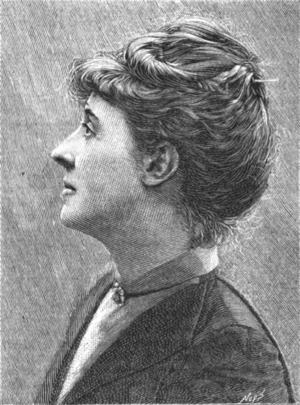Mona Caird facts for kids
Quick facts for kids
Mona Caird
|
|
|---|---|

Engraving based on a photograph by H. S. Mendelssohn
|
|
| Born | Alice Mona Alison 24 May 1854 Ryde, Isle of Wight, England |
| Died | 4 February 1932 (aged 77) Hampstead, London, England |
| Pen name | G. Noel Hatton |
| Occupation | Essayist, novelist, social reformer |
| Subjects | Feminism, civil liberties, animal rights |
| Literary movement | New Woman |
| Years active | 1883–1931 |
| Spouse |
James Alexander Henryson
(m. 1877; died 1921) |
| Children | 1 |
Alice Mona Alison Caird (born Alison; 24 May 1854 – 4 February 1932) was an English writer. She wrote novels and essays. Her ideas about feminism (equal rights for women) caused a lot of discussion in the late 1800s. Mona Caird also spoke up for animal rights and civil liberties (basic freedoms for people). She helped promote the idea of the "New Woman" in public life. The "New Woman" was a term for independent and educated women who challenged traditional roles.
Contents
Mona Caird's Early Life
Mona Caird was born in Ryde, on the Isle of Wight, England. She was the older daughter of John Alison and Matilda Hector. Her father was from Scotland, and her mother was from Germany.
From a young age, Mona loved to write stories and plays. She was good at French, German, and English. In December 1877, she married James Alexander Henryson. He was a farmer in Scotland. Her husband supported her independence. While he lived on their estates, Mona spent a lot of time in London and traveling. She met many writers, including Thomas Hardy, who liked her work. Mona and James had one son, born in 1884, named Alison James, but she called him Alister.
Speaking Up for Women
Mona Caird first published two novels using the pen name "G. Noel Hatton." But these books did not get much attention. Later, she started using her own name for her writings.
She became well-known in 1888. This happened when she wrote an article called "Marriage" for the Westminster Review. In this article, she talked about the challenges women faced in marriage. She said that marriage at the time was "a vexatious failure." She believed that husbands and wives should be equal and independent.
The Daily Telegraph newspaper responded to her article. They started a series called "Is Marriage a Failure?" This series received many letters from people all over the world. It continued for three months. Mona Caird felt her ideas were misunderstood. So, she wrote another article called "Ideal Marriage" later that year. Many of her essays about marriage and women's issues were collected in a book. It was called The Morality of Marriage and Other Essays on the Status and Destiny of Women (1897).
Her Famous Novels
Mona Caird then published the novel The Wing of Azrael (1889). In this story, a character named Viola Sedley defends herself against her cruel husband. Next, she released a collection of short stories called A Romance of the Moors (1891). In the main story, a widowed artist helps a young couple. She advises them to be independent and self-sufficient.
Her most famous novel is The Daughters of Danaus (1894). It tells the story of Hadria Fullerton. Hadria dreams of becoming a composer. But her duties to her family, parents, husband, and child leave her little time for her dream. This book is now seen as an important feminist story. Another well-known short story is "The Yellow Drawing-Room" (1892). In it, Vanora Haydon challenges the usual separation of roles for men and women. These works are often called "fiction of the New Woman."
Fighting for Rights
Mona Caird was active in the women's suffrage movement from her early twenties. This movement worked to get women the right to vote. She joined several groups, including the National Society for Women's Suffrage in 1878. She also joined the Women's Franchise League and the London Society for Women's Suffrage.
In 1892, her essay "Why Women Want the Franchise" was read at a conference. In 1908, she wrote "Militant Tactics and Woman's Suffrage." She also took part in a large women's suffrage protest in Hyde Park.
Against Animal Testing
Mona Caird was also against vivisection. Vivisection is the practice of doing experiments on live animals. She wrote many pieces about this topic. These included "The Sanctuary of Mercy" (1895) and "Beyond the Pale" (1896). She also wrote a play called "The Logicians: An episode in dialogue" (1902). In this play, characters discuss different views on animal testing.
Later Works and Legacy
From 1904 to 1909, Mona Caird was a member of the Theosophical Society. This was a group interested in spiritual and philosophical ideas.
Among her later writings is a travel book with pictures, Romantic Cities of Provence (1906). She also wrote more novels. The Stones of Sacrifice (1915) showed the harmful effects of women sacrificing too much for others. Her last novel, The Great Wave (1931), was a science fiction story. It criticized unfair ideas about different groups of people.
Mona Caird passed away on 4 February 1932 in Hampstead, London. She was 77 years old.
See also
In Spanish: Mona Caird para niños

